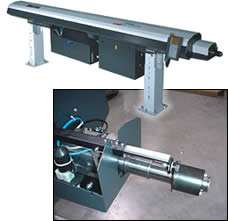Accurate Barstock Alignment Provides Faster Speeds
Recent developments in sliding-headstock turning machines allow for faster feed rates and higher spindle speeds—both aimed at increasing throughput to improve productivity. Sometimes, though, these machines cannot reach their full potential because of other equipment that runs in conjunction with it.
Recent developments in sliding-headstock turning machines allow for faster feed rates and higher spindle speeds—both aimed at increasing throughput to improve productivity. Sometimes, though, these machines cannot reach their full potential because of other equipment that runs in conjunction with it.
Sometimes the bar feed equipment is not capable of keeping up with the motion and movement of the sliding headstock to allow maximum feed rates and spindle rpm without damage to the barstock, workpiece or machine tool. This issue often occurs when producing small-diameter parts or long shafts, maintaining higher tolerances or cutting special materials, such as titanium.
Featured Content
Some systems mount a mechanical device on the machine tool head stock and connect it directly to the bar feeder. Another type of system uses a clutch to engage and disengage a synchronization mechanism between the bar feeder and the headstock. The clutch action can create a delay that adds dwell time to the CNC program. Without the use of the clutch and the added dwell time, the headstock, bar and pusher might lose connection, or the action may bend the bar when the headstock reverses direction.
One other system simultaneously signals the machine headstock and the bar feed servodrives for barstock positioning. However, this system may not allow detection of the true physical movement of the headstock in real time.
Working with machine manufacturers, LNS America Inc. (Cincinnati, Ohio) developed a different solution to this problem. Theorizing that the only way to maximize machine tool efficiency and provide a safer working environment is to eliminate the dangerous lapse in forward and reverse acceleration, LNS created a system that maintains constant, dynamic barstock position control throughout the machining cycle.
The 3-S Intelligent Synchronization system links a controller, strategically placed sensors and servodriven motors that are directly connected to the headstock to eliminate transmission delay. The system actually anticipates headstock motion by continuously monitoring sliding headstock and bar feeding movements. The result is precise synchronization of the movements of the pusher and the lathe headstock, virtually eliminating barstock misalignment and allowing the machine tool to operate safely and at peak efficiency. Regulated pressure also helps to eliminate the safety hazards often experienced with bending or broken barstock during backward acceleration.
Highland Products, a Mentor, Ohio, machine shop recently applied the 3-S system. As Highland’s Matt Nolan explains, “To improve productivity, we recently installed a new, faster Swiss-style machine to cut 2.4-mm-diameter stainless steel bars. To achieve our objectives, we needed to feed 12-foot barstock into the new machine rather than waste time and materials cutting the stock to 6-foot lengths.”
“Unfortunately, the speed of the new CNC machine and the amount of servo pressure on the back of the bar made it difficult to feed the 12-foot steel without periodic bending of the bars. We checked with LNS and learned that we could retrofit our existing LNS bar feed with the 3-S synchronization system. I ordered the retrofit kit and installed it in less than an hour. Now we have no problem running the 12-foot bars. The system is running flawlessly.”
Intelligent Synchronization is available exclusively on current LNS Express 320 and 220 series automatic bar feeds and is retrofittable. This series of automatic bar feeders is designed for any fixed or sliding headstock turning machine, including right- or left-hand models with front or rear load. Partial change-overs can be performed in 2 minutes by entering the shape, bar diameter, part length and guiding channel ID. Complete change-over, with guide channels, pusher, collet and safety connection telescopic tube liner takes 8 minutes or less.
The 3-S synchronization option is especially recommended for high-speed sliding headstock machines, for small-diameter (less than 3 mm) bars and when running special materials such as titanium.
RELATED CONTENT
-
Automation in High-Mix, Low-Volume Turning Applications
Turning shops are familiar with automation for high-volume work, but the shifting landscape to smaller batch sizes has created new challenges.
-
Checklist for Lights-Out Manufacturing
Many shops of various sizes are trying to hop on the lights-out bandwagon. This article looks at some things to consider and check out before “hopping.”
-
Bar Feeder Basics
Some primary factors are often overlooked when considering how to justify the implementation of a bar feeder for turning operations.





.jpg;width=860)





